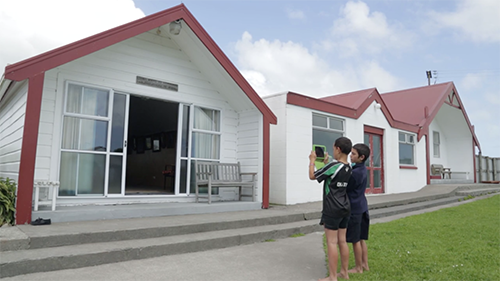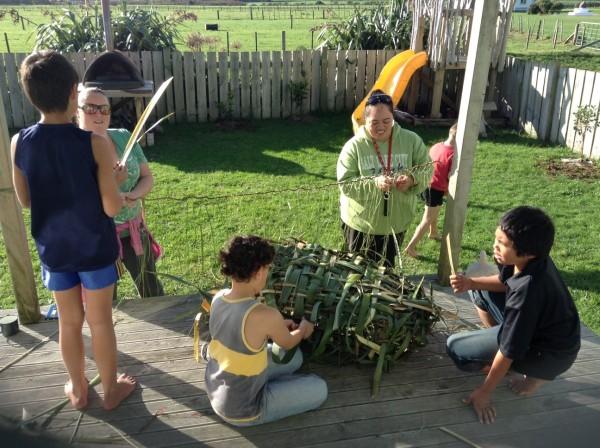Te ika unahi nui wānanga – A marae-based learning programme
Tags: Distance learning | Home-school partnership | Tikanga Māori | Primary |
Te Ika Unahi Nui is a marae-based wānanga (learning programme) that was developed and trialled with students from Coastal Taranaki School at Puniho Pā, Tarawainuku marae in Okato, Taranaki.
The wānanga is a partnership between the marae, Coastal Taranaki School, and the local community. The marae holds the cultural knowledge of the local tribe inside its houses and in the local environment – the river, the land, and the mountain.
e-Learning facilitator, Jason Ruakere worked with students, whānau, and teacher Chris Luke on the programme.
Purpose
The intentions of the wānanga (learning) were to:
- develop a local curriculum – strengthening the relationship between the school, whānau, and the local marae
- strengthen cultural identity and cultural capability through marae-based learning
- support literacy learning and digital fluency by using iPad apps to create pepeha and traditional stories.
The intentions of Te Ika Unahi Nui wānanga aligned with the school’s vision, strategic direction and charter, and built on from previous initiatives the school had implemented.
Over the course of a year, a group of Māori boys in Years 6 and 7 from Coastal Taranaki School worked for one morning a week with Jason on their local marae to:
- develop leadership, literacy, and life skills
- connect with their language and culture
- improve learning through the effective use of technologies.
e-Learning facilitator, Jason Ruakere, students, and teacher, Chris Luke, talk about the difference marae-based learning supported by digital technologies has made to students confidence and identity.
Building cultural capability
Wānanga took a hands-on approach with purposeful activities in authentic contexts.
Students strengthened their cultural identity as they learned:
- stories of the whenua (land) and climbed Mt Taranaki – their maunga
- tikanga through traditional methods of food gathering including weaving hīnaki (fishing nets), catching and smoking eels, making a fire, and growing kumara
- te reo Māori through waiata and creating their pepeha.
Students describe their model of the marae in Māori using Tellagami. Using concrete materials supports the boys to structure their explanation and describe the key aspects of their marae.
Teacher, Chris Luke explains the importance of marae-based learning and how he connects the students' learning at the marae with the learning in the classroom. Parents describe how marae-based learning gives an authentic learning experience for their children, "Having the kids learning on the marae, knowing their tikanga, their te reo, and using the iPads and bringing it into the school, into the home, I just find that really good for everyone."
I like going to the marae because I learn stories about my culture, and the names of the whare, and my pepeha. When I first came here I wasn’t very confident talking in front of people. Now that I come here my confidence is going up.
– Student comment
Building digital fluency
Each student used an iPad at the marae. They used Book Creator , Tellagami, PicCollage , and Strip Designer to create their pepeha and record stories from the marae. Using these digital technologies removed writing barriers and whakamā (shyness). The boys built confidence in themselves as learners and creators of knowledge within a context that valued their culture.
Manawairua's pepeha about Karakatonga Pā created with Tallegami
More detailed information about the learning programme
Te Ika Unahi Nui blog – what happened each week, the vision, outcomes, programme
Connecting with whānau to develop a local curriculum
Whānau were invited to partner in designing learning experiences. Meetings were held to discuss and plan learning for each term.
Regular, ongoing communication with whānau was maintained through:
- texting
- writing a pānui (notice) in the school blog
- phoning them
- talking to them incidentally at the rugby field, skatepark, or local Four Square.
Parents and whānau were encouraged to participate in the learning experiences at the marae each week with the students. They taught traditional skills and shared stories with the boys.
Parents noticed the differences the learning approach was making for their children.
Probably one of the biggest things with the programme is Tuawaerenga came home really engaged and motivated in what he’s been doing...the other day we were driving into New Plymouth and he asked, Hey mama, do you know how Taranaki got it’s name?...He retold the story using all the detail with the right kupu...He knew exactly what it was all about. We picked up the cell phone and he recorded it. He’s starting to use devices like he never did before.
– Parent comment
Parents and students describe building confidence in themselves as learners and strengthened whānau relationships, leading to increased engagement and improved learning outcomes.
Local curriculum and place-based learning
Students built their te reo Māori and understanding of Māori history and tikanga in their local area through:
- setting up the marae, welcoming visitors, and preparing food
- learning about their local marae – their local iwi, maunga, awa, waka, names of the houses
- learning and re-telling stories about the local area and tribe, particularly the maunga both orally and digitally
- speaking basic te reo Māori with excellent pronunciation
- standing and sharing their mihi to visitors to the marae
- making traditional hinaki and catching eels
- learning basic basic bushcraft skills required to stay overnight on the mountain.
At school when we do te reo we don’t have like all the whare and stuff to see, and when we’re here you can like go around and look, and be able to see the things.
– Student
I like having the experiences, like going out Pouakai Hut and making the hīnaki and trying to catch the eels...And also we’ve been doing like making fire, watching videos, learning how to make knots with ropes.
– Student
The relationship between the school and the whānau was strengthened. Whānau felt valued because:
- the school recognised and acknowledged the significance of marae-based learning
- their language and culture was a valued part of learning
- their boys' confidence as speakers in te reo Māori grew and they were proud of their culture
- the boys were discussing and sharing their learning whānau.
Digital fluency and literacy learning
Students learnt to use a range of iPad apps to support and share their learning with whānau and their classmates at school.
Using concrete materials to make short videos supported planning, sequencing, and retelling. Students learned and used simple sentence structures in te reo Māori.
I like doing the activities we do on the iPads and learning more about how to speak Māori, and going around the places finding out what the names are.
– Student
Chris Luke, te reo Māori teacher at Coastal Taranaki School comments on the value of structuring the Te Ika Unahi Nui wānanga so it is regular and works for everybody. The whānau know what’s going on and are involved. Students share the benefits of practical experiences supported by learning with digital technologies.
Resources and readings
Cultural capability
NZ Curriculum online draws together research, digital resources, and examples to support schools as they consider the cultural diversity principle.
Ensuring culturally responsive practice
This page on Educational Leaders summarises some thinking and research related to this capability.
Free resources from CORE Education to support understanding Te Tiriti o Waitangi and using Te Reo Māori to build cultural capability.
Enabling e-Learning
Practical examples from NZ schools and useful resources.



